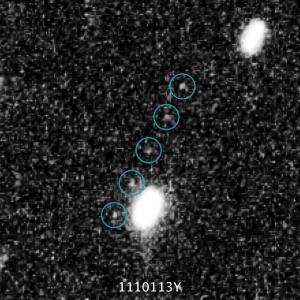Blog
A Billion Miles Further
14 January 2018
The New Horizons Pluto flyby was an ambitious mission. At the time of launch, its destination was known only as a blurry distant body. We knew some of its properties, such as its mass and rough surface coloring, but we weren’t even certain of its exact size. But the laws of gravity are extremely precise, so we could ensure New Horizons would reach its target. The mystery was what it would find.
What New Horizons discovered surprised us all. Rather than a cold inert world, we found Pluto has a thin atmosphere, that it has icy mountains, and is likely thermally active. The mission showed us just how strange and wondrous the solar system could be beyond Neptune. It piqued our interest in similar distant bodies.
 NASA, ESA, SwRI, JHU/APL, and the New Horizons KBO Search Team
NASA, ESA, SwRI, JHU/APL, and the New Horizons KBO Search TeamWe know even less about other worlds. Their tremendous distance and small sizes make them difficult to study. We have discovered lots of objects, some with rings, some with moons, and some even larger than Pluto. But each of these are seen only as small blurry dots even with our best telescopes. A mission to any of these worlds would be as costly as New Horizons, and would be a difficult sell in our current economic environment.
So the New Horizons team looked for distant worlds their spacecraft might be able to reach. They settled on a small body known as 2014 MU69. Discovered eight years after the launch of New Horizons, it is a small world only about 20 to 30 kilometers wide. From the blurry images we have, it appears to be a close or contact binary, similar to the comet 67P/Churyumov-Gerasimenko. It’s difficult to tell, because 2014 MU69 is about a billion miles further away from the Sun than Pluto, or about 25% more distant. We do, however, know the path of its orbit, and with the equations of Newton’s gravity the New Horizons team knows it can reach it.
The date of the flyby is now scheduled for 1 January, 2019. To save power, the spacecraft is currently in hibernation until June. By August it will have woken up and will start taking images of 2014 MU69. These will help pinpoint the exact path for New Horizons, and ensure a close and safe flyby.
This extended mission is a huge challenge. We’ve never attempted such a distant flyby, and even less is known about 2014 MU69 than was known about Pluto. But the rewards promise to be huge. For the first time we will observe a body in the outer solar system close-up. It promises to be just as surprising as Pluto, if not more.